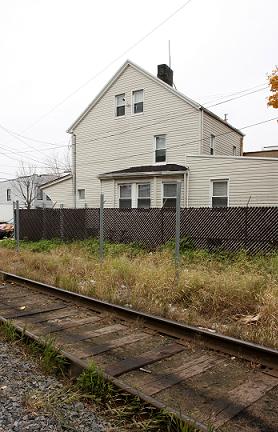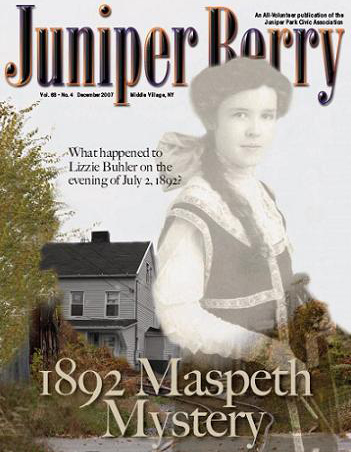Immediately upon notification to the police, a radio car would respond along with a patrol supervisor (Sgt or Lt).
After the obvious determination of the decedents condition, a crime scene would be established by the highest-ranking uniformed member at the scene. If only patrolmen (or women!) were on the scene, the senior member would take charge, pending the arrival of a supervisor and the detective squad.
The famed yellow crime scene tape would be placed around the entire vicinity of the body. It would be a very wide “zone.” The purpose would be to protect the integrity of the evidence that may be in and around the body, plus any path(s) the victim and potential killer may have utilized.
As the scene is being taped off, another officer would be culling onlookers asking for witnesses of any type. Whether it were eyewitnesses to seeing Lizzie alive the night before, or anyone (Krummick, the Breedens) who saw the body prior to police arrival.
These witnesses would be separated from one another to minimize the chances of them exchanging what they each observed, so as not to further influence their memories and observations. They would be identified, and if they tried to leave the area, could legally be held as a material witness to a potential homicide. Each witness will be asked to provide a very brief summation of what they saw (or possibly heard). The in depth probing is left to the detectives.
Upon the arrival of the detectives, the highest-ranking detective bureau member is now in charge at the scene. They interview the patrol officers and get they're take on the crime scene and it's condition prior to the yellow taping. They retrieve the names of the held witnesses, discern what of value they have to offer in way of observations and have patrol keep them at the ready for questioning. If anyone is identified as having germane and credible information, that person would be questioned immediately. If the info appears legit, the detectives would have the witness(es) transported (separately, if 2 or more) to the station house where they will be debriefed in depth upon conclusion of the crime scene investigation.
A detective would ensure a “canvass” of the surrounding area, both businesses and residences, were conducted. This would be accomplished by patrol members with a detective not assigned as a lead investigator coordinating the canvass vicinity. Should a solid witness emerge, that detective would begin the debriefing process.
A patrol officer would be assigned to the crime scene entry point (outside of the tape) to prevent any unauthorized people (including other cops) from entering the scene and causing further “contamination.” This officer would keep a log of ALL members entering into the crime scene, and would be supplied with all the identities of ALL those who preceded the detectives into the scene. This list would include witnesses, and all first responders. The purpose of this would be to rule out labeling anything as “evidence” from a potential suspect, such as cigarette butts, discarded beer cans, footprints, clothing fibers, etc., that may have inadvertently been placed there by one of the aforementioned.
Simultaneous to the canvass, detectives would begin the actual scene investigation. They would visually examine the remains, looking for any injury inconsistent with the train impact (the blows to the head ). If any relevant information was gleaned from eyewitnesses (for example “I saw a guy running through that path right before I found the body.”), the direction of the field investigation would naturally be guided by that information. After determining the victim was most likely assaulted prior to the train impact, the detectives would place bags over both of her hands in order to preserve any evidence that may be under her fingernails. A request for “nail scraping” from the medical examiner would be ordered hoping to yield her assailants skin in her attempt to defend herself.
They then would work the scene “outward”, gradually enlarging the crime scene search in a circular pattern, searching for any evidence. Blood stains, discarded items of any type, most especially freshly discarded items, any potential weapons (including anything that could be used in blunt force such as thick sticks, pipes, etc.) Tire tracks and footprints would be examined, and marked off, for preservation via plaster casting. Photographs of the entire scene would be taken. Crime Scene specialists are dispatched (automatically in homicide cases) to deal with the forensics (such as the plaster casting and photography).
After the careful and methodical examination of the scene, the detectives huddle and begin to theorize on the possible circumstances. A consensus is generally reached as a team as to what may have transpired, and what direction to follow in the post scene investigation. A painstakingly thorough, detailed and complete profile background will be conducted on the victim. Starting with those closest to her (immediate family), next her employers (The Schneiders) and gradually spreading wider (think “outward” again) to include close friends, acquaintances, neighbors, shop keepers, and most especially, most especially, any prior or current love interests. A full, well-rounded profile will usually yield several leads. These leads would be investigated to exhaustion.
As one team is conducting the background investigation, another team would deal with the witnesses and whatever information they provide. Again, working outward (detecting a pattern here?..Gumshoe 101!) it would include a re canvassing of the still secured crime scene and its vicinity in case something or someone was missed (such as video cameras). Business cards and fliers would be distributed throughout the area, imploring people to call with any information, anonymously if they prefer. The railroad would be brought into the investigation at this time. The engineer would be thoroughly debriefed and his scheduling time lines would be established. How many times did he pass through the crime scene, at what approximate times, were there any passengers at all during any of his runs, etc.
The teams would be in frequent communication as leads develop or wither and the constant investigative adjustments are made. Comparisons that would fit or disprove theories are analyzed by all as the evidence begins to mount, however circumstantial. The autopsy results (revealing the pregnancy, potential assailant DNA such as blood, or skin) coupled with the lab analysis performed (foreign hair fibers, clothing fibers, anything relevant found at the crime scene) will yield further leads. Any foreign DNA recovered would be tested in a databank for comparisons to any on file.
The teams would then conference and compare all that is learned. A list of suspects is identified as a result of the conference and those suspects are then searched for and brought in for questioning.
Any major inconsistencies discovered in the accounts of the suspects (i.e. false time lines, unexplained whereabouts between 10:30 pm and 5:30am or Easer's denial of “attention” to the victim when the profile proved otherwise) and culpable statements raises a legal standard for custodial interrogation and tips the balance in favor of law enforcement. They would be checked for any wounds, such as bruises or scratches and be made to explain precisely how they occurred. (Think Robert Chambers in the Central Park murder of Jennifer Levin. He had facial scratches. Or O.J. Simpson, with the cuts to his hands). At this point search warrants may be applied for covering such issues as a suspects clothing and the court ordered approval of taking DNA samples from the suspect. The suspect will be asked to voluntarily submit to the search and DNA sample. At this point, if he refuses, Miranda warnings must be given so as not to nullify any evidence taken from the suspect from this point forward. Short of a confession, or iron clad DNA evidence, there would not yet be enough for an arrest and the suspect would be free to leave. But the detectives would be exclusively focused on that individual until every lead is exhausted. The search warrants would provide the vast bulk of proving or disproving the suspects involvement with the victim, with the detailed following up of his statement right behind it.
If all that fails to provide the detectives with a definitive suspect, and everyone has an airtight alibi, including baby's father (assuming he's identified) we would, you guessed it, work “outward” yet again.
In the second paragraph, the article states, “another murder is added to the long list of those which have occurred on the outskirts of Brooklyn.” Ok, the detectives would then delve headlong into every one of those unsolved murders, comparing the Buhler case with the unsolved cases, looking for common threads. If there are evidentiary matches, perhaps they now have a previously unknown serial killer on their hands. (Son Of Sam was pieced together through ballistics. Prior to that, his shootings were not deemed related)
All local recently released convicts and parolees would be looked at. Once again, nearby residents and merchants would be questioned as to any strangers, or drifters in the area prior to the murder. Truth be told, if this failed to yield any leads, you now would have a classic “Cold Case.”
The best that could be done in that circumstance would be to notify all squads throughout the city about your unsolved case, and ask that when they debrief their arrestees, to ascertain if they have any information about the case with a promise of legal consideration for their assistance.
In addition, any foreign DNA taken from the victim will be routinely tested against newer entries into the databank. This has solved many murders and sexual assaults over the last 10 years or so.
Unsolved homicides are NEVER officially closed cases. They are given to the Cold Case squad and are deemed “inactive” pending further investigatory evidence.




